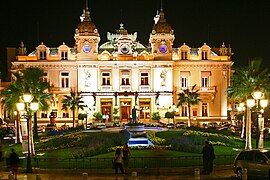French Riviera
| |
|---|---|
|
Clockwise from top: a view of Èze with Saint-Jean-Cap-Ferrat; old town of Saint-Tropez; Monte Carlo Casino in the Principality of Monaco; and the city centre of Nice | |
 | |
| Coordinates: 43°19′12″N 06°39′54″E / 43.32000°N 6.66500°E | |
| Country | France Monaco |
| Website | cotedazurfrance |

The French Riviera, known in French as the Côte d'Azur (IPA: [kot dazyʁ]; Provençal: Còsta d'Azur, IPA: [ˈkwɔstɔ daˈzyʀ]; lit. 'Azure Coast'), is the Mediterranean coastline of the southeast corner of France. There is no official boundary, but it is considered to be the coastal area of the Alpes-Maritimes department, extending from the rock formation Massif de l'Esterel to Menton, at the France–Italy border, although some other sources place the western boundary further west around Saint-Tropez or even Toulon.[1] The coast is entirely within the Provence-Alpes-Côte d'Azur region of France. The Principality of Monaco is a semi-enclave within the region, surrounded on three sides by France and fronting the Mediterranean. The French Riviera contains the seaside resorts of Cap-d'Ail, Beaulieu-sur-Mer, Saint-Jean-Cap-Ferrat, Villefranche-sur-Mer, Antibes, Juan-les-Pins, Cannes, and Theoule-sur-Mer.
Riviera is an Italian word that originates from the ancient Ligurian territory of Italy, wedged between the Var and Magra rivers. Côte d'Azur is originally a nickname given by France to the County of Nice after its annexation in 1860, because the climate was similar to that of the north of Italy, even in winter, with "a sky as blue as its sea". When the Mistral (north) and the Tramontane (Northwest) winds are blowing in the Languedoc and Provence areas, the temperature of the Mediterranean can be very cool in summer. This phenomenon is observed very little or not at all on the coast between the French Riviera and the Italian Riviera.[2]
This coastline was one of the first modern resort areas. It began as a winter health resort for the British upper class at the end of the 18th century. With the arrival of the railway in the mid-19th century, it became the playground and vacation spot of British, Russian, and other aristocrats, such as Queen Victoria, Tsar Alexander II and King Edward VII, when he was Prince of Wales. In the summer, it also played home to many members of the Rothschild family. In the first half of the 20th century, it was frequented by artists and writers, including Pablo Picasso, Henri Matisse, Francis Bacon,[3] Edith Wharton, Somerset Maugham and Aldous Huxley, as well as wealthy Americans and Europeans. After World War II, it became a popular tourist destination and convention site. Many celebrities, such as Elton John and Brigitte Bardot, have homes in the region.
Officially, the French Riviera is home to 163 nationalities with 83,962 foreign residents,[4] although estimates of the number of non-French nationals living in the area are often much higher.[5] Its largest city is Nice, which has a population of 340,017 as of 2017.[6] The city is the centre of a métropole—Nice-Côte d'Azur—bringing together 49 communes and more than 540,000 inhabitants and 943,000 in the urban area. Nice is home to Nice Côte d'Azur Airport, France's third-busiest airport (after Charles de Gaulle Airport and Orly Airport), which is on an area of partially reclaimed coastal land at the western end of the Promenade des Anglais. A second airport at Mandelieu was once the region's commercial airport,[7] but is now mainly used by private and business aircraft.[8]
The A8 autoroute runs through the region, as does the old main road generally known as the Route nationale 7 (officially now DN7 in Var and D6007 in Alpes-Maritimes).[9] High-speed trains serve the coastal region and inland to Grasse, with the TGV Sud-Est service reaching Nice-Ville station in five and a half hours from Paris. The French Riviera has a total population of more than two million. It is home to a high tech and science park (French: technopole) at Sophia-Antipolis (north of Antibes) and a research and technology centre at the University of Nice Sophia Antipolis. The region has 35,000 students, of whom 25 percent are working toward a doctorate.[10] The French Riviera is a major yachting and cruising area with several marinas along its coast. According to the Côte d'Azur Economic Development Agency, each year the Riviera hosts 50 percent of the world's superyacht fleet, with 90 percent of all superyachts visiting the region's coast at least once in their lifetime.[11] As a tourist centre, the French Riviera benefits from 310 to 330 days of sunshine per year, 115 kilometres (71 miles) of coastline and beaches, 18 golf courses, 14 ski resorts and 3,000 restaurants.[12]
- ^ "La Côte d'Azur : ça commence et s'arrête où ?". France 3 Provence-Alpes-Côte d'Azur (in French). 8 May 2022. Archived from the original on 26 July 2023. Retrieved 26 July 2023.
- ^ "Climat : Tropicalisation des nuits azuréennes". www.meteofrance.fr. Archived from the original on 22 July 2024. Retrieved 2 December 2020.
- ^ Wrathall, Claire (6 July 2016). "Francis Bacon's Monaco magic is highlighted in a new exhibition". The Telegraph. ISSN 0307-1235. Archived from the original on 12 January 2022. Retrieved 18 December 2018.
- ^ INSEE 1999 census
- ^ e.g. Comité Régional du Tourisme Riviera Côte d'Azur.
- ^ Téléchargement du fichier d'ensemble des populations légales en 2017 Archived 5 October 2020 at the Wayback Machine, INSEE
- ^ Official site: Cannes.aeroport.fr Archived 28 April 2013 at the Wayback Machine
- ^ Official site: Cannes.aeroport.fr Archived 18 May 2009 at the Wayback Machine
- ^ National 7 website: Nationale7.com Archived 3 March 2010 at the Wayback Machine
- ^ Sirius CCINCA.
- ^ Côte d'Azur Economic Development Agency – p.31 CRDP-Nice.net Archived 4 July 2010 at the Wayback Machine
- ^ Côte d'Azur Economic Development Agency, op.cit. p.66



